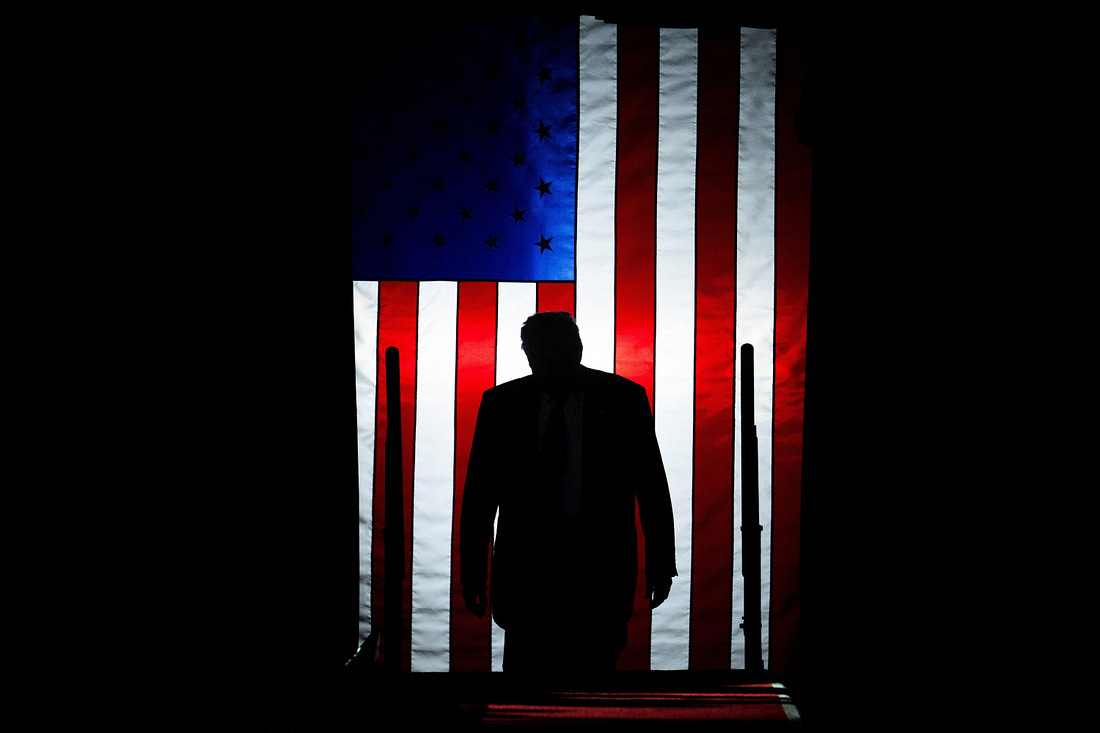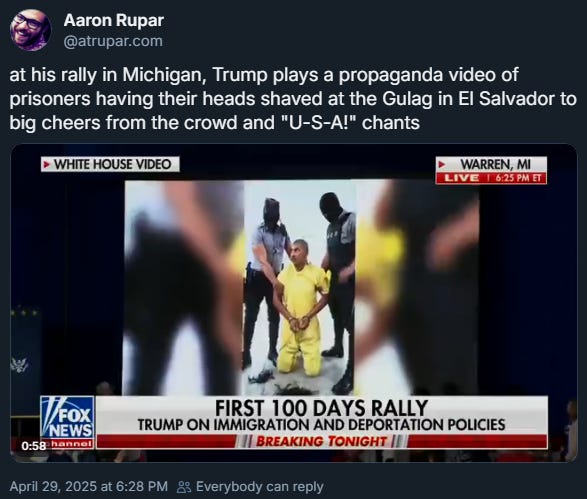How to Prepare For Trump’s Next 1,361 DaysThere is room for hope and cause for alarm about the road ahead.Bad business days loom, Reuters reports:
Sounds bad, but probably nothing a few more whiplash-inducing tariff changes won’t fix. You’ve got to let the guy cook, right? Happy Wednesday. Days 101 to 1,461 Matter Tooby William Kristol It’s been an exhausting 100 days. And we have 1,361 more to go. Or, to put it another way: We’re only about seven percent of the way through Trump’s presidential term. The overwhelming and decisive part of the challenge we face lies before us. It’s important not to be overwhelmed by the realization that this major assault on the rule of law, on our government institutions, on civil society, on the international order, has only just begun. It’s also important not to succumb to wishful thinking that we’ve seen the worst of it. It may be that the most intense phase of the offensive is subsiding. But that’s not certain. And in any case, a grinding assault for the next hundred days, and the hundred days after that, and the hundred days after that—that won’t be easy to deal with either. The shock and awe of DOGE may be mostly spent. But the implementation of Schedule F, announced without much fanfare, will turn tens of thousands of civil service jobs into political appointments at the disposal of Cabinet secretaries and ultimately of the president. And that’s only about to begin. Indeed, the purging of the key power ministries has only just begun. The full weaponization of the law enforcement agencies, the politicization of military promotions, the all-out deployment of the tools of crony and corporate capitalism—all of this has just begun. And it will likely get worse. What will Pam Bondi’s Justice Department look like after another hundred days? Will there be more men and women there trying to resist the corruption of federal law enforcement? Or will it feature more individuals committed to the Trumpist project? And what about the hundred days after that? Worse yet, presumably. The courts have been a bastion in defense of the rule of law. It was wise of the Framers to insist on life tenure for judges. But of course Trump will get a fair number of judicial appointments in the next year and a half. If Republicans hold the Senate in 2026, he’ll get even more appointments for the two years after. Besides, there are limits to what the courts can do. Not everything that damages a free country can be stopped by the judiciary. Replacing the civil service system, meddling in military promotions, pressuring business leaders—much of this is neither unconstitutional nor necessarily illegal. Public opinion is turning against the Trump administration, which is important. But a determined president with loyal and unprincipled subordinates in charge of a large executive branch, with a Congress controlled by his own party, a party which in turn is wholly subservient to him: That is a Godzilla that can keep moving ahead even with valiant attempts to interrupt its progress. If Congress starts to weigh in, that can really make a difference. But that would require defections from the forces of appeasement and acquiescence that control the Republican Party. This could happen. It hasn’t yet. Probably the closest comparison to the present moment is Nixon’s second term. But Nixon was far more limited in his authoritarian ambitions than Trump. Nixon’s Justice Department was independent enough to force the resignation of Vice President Spiro Agnew, who was replaced by Gerald Ford. Nixon was forced to resign the next year, thanks in part to hearings held by a Congress controlled by the Democratic Party, but also featuring some independent-minded Republicans. So Ford took over, and our relatively short national nightmare was over. It’s obvious that fifty years later, we’re in a very different world. The threat posed by Trump dwarfs that of Nixon. So where do we stand? Many of the Trumpist authoritarian efforts are meeting resistance, as seen in the courts, the polls, and the courage of some institutions—Fight On, Fair Harvard! On the other hand, the authoritarian project is moving ahead on many other fronts, picking up momentum so that it will be harder to resist later, let alone roll back. There are some grounds for hope. But there are probably even more grounds for alarm. But alarm need not be, it should not be, paralyzing. It needs to result in, as Longfellow wrote of the midnight ride of Paul Revere, “a cry of defiance and not of fear.” Can You Order a New Spine on Prime?by Andrew Egger Under any other administration, what unfolded yesterday between the White House and Jeff Bezos would have come as a massive shock. Early yesterday morning, Punchbowl News reported that Bezos’s Amazon was planning to start listing how much of a given item’s cost was now derived from tariffs—a change that would have spotlighted some of the hidden costs of Trump’s trade wars for millions of Amazon shoppers. The report was based on only a single unnamed source. Nevertheless, the White House went berserk. Minutes after the story broke, Press Secretary Karoline Leavitt took to her podium to proclaim that Amazon had committed “a hostile and political action.” Meanwhile, Trump dropped everything to get Bezos on the phone. Within minutes, Amazon was ferociously cleaning up the mess. “The team that runs our ultra low cost Amazon Haul store considered the idea of listing import charges on certain products,” spokesman Tim Doyle said in a statement to The Bulwark and, presumably, one hundred million other outlets. “This was never approved and is not going to happen.” But was it an idea simply under consideration or one that the White House killed? Trump himself seemed to suggest the latter. “Jeff Bezos is very nice. Terrific,” he told reporters yesterday afternoon. “He solved the problem very quickly.” On the merits, the White House’s white-hot reaction here was absurd. Why would it be any more “hostile and political” to display an item’s tariff costs than it is to display the sales tax paid on an item, as practically every retailer in America already does? Leavitt’s other simultaneous attacks on Amazon—brandishing a 2021 Reuters report of Amazon turning off product reviews in China to accuse them of partnering with a “China propaganda arm,” and demanding to know why Amazon didn’t “do this when the Biden administration hiked inflation”—were equally grasping. The reason for the tantrum was obvious: The White House was steamed about the idea that Americans might start getting a clearer picture of how much money the trade war was taking directly out of their pockets. If any other administration were steamed about how Amazon communicated this cost hike to their customers, Amazon would be perfectly comfortable telling them politely to pound sand. And yet this is not any other administration. And there’s little question that Bezos acted rationally when he squashed the idea. If you’re a titan of business today who gets crosswise of Team Trump, it barely matters whether that’s happening for reasonable reasons or for the most maniacal ones imaginable. All that matters is whether the White House considers you a friend to be praised and propped up—or an enemy to be crushed. Back in October, I wrote about how Trump’s proposed mega-tariff agenda would mean “a massive increase in the president’s discretionary control over various parts of the economy through the distribution of waivers and exclusions.” Trump-favored businesses and industries would be the ones who got trade policy tweaked to their benefit; disfavored ones would be left out in the cold. This prediction has held up well. But I didn’t dream at the time—did anybody?—how much farther Trump would push. He isn’t just giving goodies to favored parts of the private sector, he’s wielding naked retribution against business foes: law firms that ever dared cross him, media companies that particularly pissed him off. There’s no denying this approach has paid dividends. Just yesterday, the New York Times reported that Paramount, which owns CBS News, is preparing to settle with Trump in his ridiculous lawsuit concerning a 60 Minutes interview of Kamala Harris last year. The blowback from Trump has prompted Paramount to take a tighter leash on CBS programming: 60 Minutes anchor Scott Pelley said this week that Paramount had “begun to supervise our content in new ways,” and that longtime producer Bill Owens quit over the controlling new approach. Bezos, who got in good with Trump earlier this term by publicly kneecapping his own media property, the Washington Post, understands this dynamic as well as anyone. He knows that Karoline Leavitt’s ridiculous arguments at yesterday’s briefing weren’t meant to convince the public of anything. They were a simple signal to Amazon itself: Don’t think this change won’t affect your standing. You are in danger of being tossed back across the friend/enemy line. So he backed off. Few were even surprised. And that may be what’s most appalling here. Just three months in, we’ve already all become accustomed to this new lay of the land. AROUND THE BULWARK
Quick HitsSMASHING OUR WOKE TRUMP POLICIES: To hear Pete Hegseth tell it, it was the next bold step in purging wokeness from America’s military. “This morning, I proudly ENDED the ‘Women, Peace & Security’ (WPS) program inside the [Department of Defense],” the beleaguered defense secretary tweeted Tuesday. “WPS is yet another woke divisive/social justice/Biden initiative that overburdens our commanders and troops.” For good measure, he added that the program was part of the United Nations and “pushed by feminists and left-wing activists.” Just one little problem: WPS—which, according to the law creating it, is intended to encourage “meaningful participation of women in conflict prevention and conflict resolution”—is not a “Biden initiative” at all. It’s a Trump-signed 2017 law co-sponsored by two of Trump’s current cabinet officials, Secretary of State Marco Rubio and Homeland Security Secretary Kristi Noem. Rubio praised Trump for signing the bill into law at a State Department event less than a month ago, and the group “Women for Trump” listed WPS among its reasons for arguing that Trump “did more for Women than any administration in history” during his first term. Someone who still works at the Defense Department must have eventually shared this uncomfortable fact with Hegseth, as two hours later he took to X again for a little damage control. “The woke & weak Biden Administration distorted & weaponized the straight-forward & security-focused WPS initiative launched in 2017,” he tweeted. “So—yes—we are ending the ‘woke divisive/social justice/Biden (WPS) initiative. Biden ruined EVERYTHING, including ‘Women, Peace & Security.’” What Biden supposedly did to ruin the program—and why he hadn’t simply announced its restoration to a supposedly pristine earlier version—Hegseth didn’t say. DO NOT UPSET THE KING: Twelve days ago, Donald Trump posed in the Oval Office with a printed picture of Kilmar Abrego Garcia’s knuckle tattoos—a marijuana leaf, a smile, a cross, and a skull, over which had been superimposed the letters and numbers “M S 1 3.” “He’s got MS-13 tattooed onto his knuckles,” Trump tweeted then, prompting many to wonder: He knows that’s just someone’s guess as to what the actual tattoos mean, right? Turns out, uh, no. Trump plainly thought that the “M S 1 3” superimposition was part of the real tattoo—a position he defended explicitly, at excruciating length, in an interview with ABC’s Terry Morgan last night. Seriously, you cannot possibly believe how long he spends dying on this hill without watching it happen yourself. All this raises an uncomfortable question: Did Trump’s aides tell him that they’d written ‘M S 1 3’ on the picture to make the association more obvious, and did he bluster ahead anyway? Or are they—as is so often the case around would-be autocrats—more anxious not to be the person to correct his errors or tell him things he might not want to hear? HOW’S THAT UKRAINE PEACEMAKING GOING? Donald Trump’s iconic chat with Volodymyr Zelensky at Pope Francis’s funeral last week was followed by a Truth Social post musing that “maybe [Vladimir Putin] doesn’t want to stop the war, he’s just tapping me along” and noises about tougher sanctions. But don’t get too hopeful: We’re now back to “I think he does [want peace], yes” and to the quaint idea that Putin’s good intentions plus Trump’s beneficent influence have kept the Kremlin dictator from conquering all of Ukraine. If Putin wants peace, it’s in very small doses. He now calls for a three-day truce for Victory Day, from May 8 to May 11 (“the barbecue truce,” some have dubbed it). Many Russia-watchers speculate that his goal is to ensure a drone-free May 9 parade in Moscow—and to butter up Trump and keep the Potemkin peace talks going. Zelensky has called the proposal “an attempt at manipulation” and countered with a call for a 30-day ceasefire. Meanwhile, Russian Foreign Minister Sergei Lavrov has restated Russia’s hardline position on a peace agreement: full recognition of Russian ownership of Crimea and the four regions of Ukraine that Russia has annexed. Also, “demilitarization and denazification” in Ukraine—i.e., regime change and disarmament. Oh, and Sen. John Kennedy (R-La.) tells Fox News that Putin has “jacked around” and “disrespected” Trump (while also taking a shot at Joe Biden’s “appeasement” of the Kremlin). Perhaps it’s a smart move: Can Trump’s ego be weaponized to pivot him away from Moscow? Hope springs eternal. —Cathy Young Cheap ShotsYou’re a free subscriber to The Bulwark—the largest pro-democracy news and analysis bundle on Substack. For unfettered access to all our newsletters and to access ad-free and member-only shows, become a paying subscriber. We’re going to send you a lot of content—newsletters and alerts for shows so you can read and watch on your schedule. Don’t care for so much email? You can update your personal email preferences as often as you like. To update the list of newsletter or alerts you received from The Bulwark, click here. |
How to Prepare For Trump’s Next 1,361 Days
April 30, 2025
0





